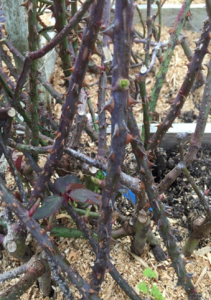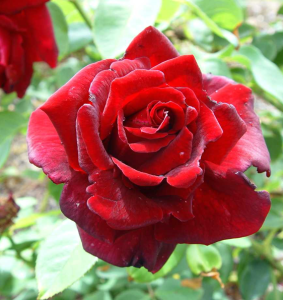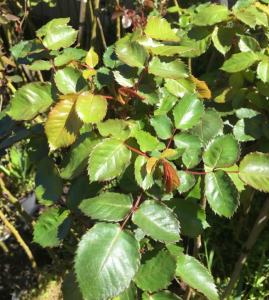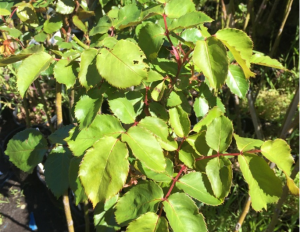At some time in a rose society member’s life someone will ask you to identify a rose for them. As a retail rose specialist one of our regular customer services we offer is the identification of roses. Each year many dozens of customers use this service and we are proud to be able to identify over 95% of all those brought in. I hope I can share with members how we go about trying to identify roses and some tips you can use to help others.
Without exception it will only be the flower they bring to show you. Most cases it is easy to identify with Double Delight, Bonica, Gold Bunny, Kardinal, Just Joey, Princess Monaco, etc., as the flower is unique and nothing to confuse you. However there will be times when the flower looks just like so many others. How can you identify these?




Even though all four pictures of rose flowers look similar, each possesses small unique features which an expert is aware of to make the identification. Number of petals, smooth edges, scalloped edges, whether it has burn or fade, size of blooms, petal formation and how it opens with full centre or with stamens exposed. If the rose is before you we also have the unique scent factor available to us. How strong is the scent, what scent type or even if scent exists.
But the flower can also be misleading. To determine what variety it is we need information from the owner. Is this a typical flower or does it change at different times of the year, does it produce singly or in clusters, how long are the stems, how healthy is the plant, how many thorns, does it produce seed pods and most importantly how old is the plant and how tall does it grow. All these factors eliminate varieties we have in our head that it could be.
Of course we do have the wonderful tool Doug Gregory (RSSA) created as a database of roses but even with this tool we still need to ask lots of questions to reduce options for the database.
As most people only bring in a flower with no other plant material this is all we have to go by. For me, and all at our nursery, the foliage is crucial for an accurate identification.
In our nursery there are many times we must identify a rose with no flowers at all. When cutting propagation material there are rarely any flowers on the plants but we know instantly if the variety is what we need, even if the label is missing. Each rose has unique foliage and thorn formation which gives more accuracy in identification. It is only when we get a Peace or Chicago Peace which have near identical foliage that it is a challenge.
During our winter selling season all we have are ‘sticks’ as bare rooted roses. Yet nearly all roses have different wood and thorn formation. It is quite possible to identify, with years in the business, well over 90% of all varieties we grow just from bare ‘sticks’.
With the knowledge of all roses we stock we can tell just from ‘sticks’ if the variety is correct. Albas looks different to Centifolias, Spirit of Peace looks different to Peace and Amazing Grace plant formation can never be confused with Pascali even though the flowers can look similar.
Below are just 4 examples of ‘sticks’ and you can see all look totally different. Once the wood and thorns can be identified you are well on your way to identify nearly any rose brought to you for identifying.

1

2

3

4
Image 1 is a hard one with many similar but thick stem is typical of Princess de Monaco.
Image 2 with the red wood is either a deep pink or red variety but is Courage for sure.
Image 3 has slightly blueish green wood and few thorns which are unique for Apricot Nectar.
Image 4 again has red wood and being thorny has to be a red. Either Papa Meilland or Oklahoma. I
would say Papa as thorns more typical.
Below I have three deep red roses. In consultation with the customer I find all are around 1.2m tall, all have high scent, do not fade or burn much and have good health.
For these three red roses each had unique foliage and thorn formation which instantly tells what the variety is.

Example 1

Example 2

Example 3
Example 1 has thorns in random partern and sizes and deep green foliage. It is Papa Meilland.
Example 2 has red thorns and red bark, petals not uniform which is unique to Red Cross.
Example 3 has very few thorns, shorter stems and small internodal spaces and leaves which are
easily identified as Josephine Bruce.
But Papa Meilland is much taller than Josephine Bruce? Sometimes we are given information but is it information that helps us? It happens that the Papa Meilland is planted under trees so stunting its growth through root competition, yet Josephine Bruce is in the shade of the house drawing it up to find the sun. Sometimes we must think outside the square to find options which normally would be eliminated from the equation.
I recall many wonderful times visiting my grandfather at his nursery. As kids we had great joy going into his garden and picking one rose petal and taking it to him to identify. He would place it in his mouth and eat it. Carla he would say – correct. Try another. Talisman he would say – correct. Never wrong. We thought he was a genious being able to taste a petal and know what rose it was. It was many years later we found out he knew what was in flower in his garden and what colour petal it had. Tasting had nothing to do with it but had us all tricked.
To be called a true rose expert you do need to know almost everything about every rose ever made. We know this is not possible but this is the degree needed to be able to see and know instantly. I am relatively new to the industry with just 40 years of varieties, probably about 1,200 varieties I would have a fair chance of knowing. Maureen Ross would easily have 30 years earlier than this and knows most roses introduced since the 1950’s and most Heritage Roses. This could easily be several thousand. We know all the rose varieties we grow but must be familiar with varieties introduced from other growers.
My late father once said to me – the more varieties you know, the less sure you are that the identification is truly correct. This is a true story that happened in our nursery some time ago but relevant to Deane’s words to me.
A customer was purchasing some plants and my brother in law was serving them and they asked if we could identify a rose growing in their garden. He had been in the business only a short amount of time but had amassed quite a bit of knowledge of rose varieties. They said it was a really deep red rose with strong scent. He said it was Mister Lincoln.
I had finished serving my customer and hearing the conversation asked the customer was it a really tall plant? I had about 15 year experience at the time so knew a few more roses it could be. No, was the answer, only about 1.2m tall. I said probably not Mister Lincoln as too short but lower growing varieties it could be Crimson Glory, Josephine Bruce or Chrysler Imperial which are all about that size.
Just at that moment my father Deane walked into the office and I asked him what this rose we were trying to identify could be. I told him the information we had and some of the guesses. He asked how old the plants were. ‘They were there when we moved into the house so probably about 50 years or more’ was the answer. Deane said he could not really say for sure unless he sees the flower and foliage and in an old garden sometime the plants could be different sizes than normal through neglect and time, but he felt the age of the plants the ones we suggested were probably not likely except Crimson Glory which was very popular at that time. He suggested it could be Hadley, Midnight, Charles Gregory, Charles Mallerin or Tassin as all were around the industry at that time and could fit the description. It all depends on where the plants were bought as each nursery has specific varieties they grow.
This is a perfect example of how the length of time working within the industry helps like nothing else can. As most society members would never come close to achieving this exposure there are several rules which I will pass on which may help to identify roses.
- Foliage Rules. Each rose, except for species, are bred from similar roses. In many cases the breeding line can be determined by just seeing the foliage and thorns. Each is unique.
- Ask lots. Flowers are one thing but size of plants and age of the plant give more criteria to determine choices. Once more information has been obtained useful databases can help give options to determine the variety.
- Elimination. It is much easier to say what it is not than what it is. We can eliminate many options due to being too thorny, wrong colour of the finished flower, wrong scent, etc. By eliminating many choices reduces the number of options available. But elimination of varieties can really only occur by those who have intimate knowledge of the roses they are eliminating. The world famous New Zealand Trevor Griffiths was trying to identify a rose and was stating what it wasn’t and the customers said to him “you don’t know much, do you”.
- Failure. Be prepared to say you don’t know or are not sure. Customers do accept what you say is correct and if given a wrong name, and they buy another expecting the same rose, can be quite annoyed.
- Conference. Be prepared to ask others. Getting a second opinion is not questioning your selection but in most cases just confirming it. It also opens up the subject for discussion and more choices may be offered which were not previously thought of.
The best identifiers have a wealth of knowledge and years of experience but with correct questions being asked, and the tremendous Doug database at our disposal, it is not impossible to give the gardener a fairly good opinion of what rose they have.
When all is said and done there will still be some that know more than you do. I have been told by a gardener (at a rose show) about their ‘bush Blackboy’. I informed them sadly there was no bush ‘Blackboy’ as the Alister Clark rose was only a climber. ‘Well you don’t know much” I was told, “I got it from a Garden Centre and it was labelled Blackboy so you are wrong”.
Just grit your teeth and smile.
For your interest I have included a few photos of just rose foliage. How many can you identify? All should be very easy for rose experts but a few may also have the skills to work out what they are just from foliage and my brief information.


Number 1 has shiny healthy foliage with new growth a reddish green in colour. The distinct sharp tooth serrations are a giveaway for this rose. The foliage colour indicates more than likely it is a yellow or white rose.
Number 2 looks sad. It is typical of this rose. Very easy to identify once you know. Healthy leaves are throwing me off the track for normally we find much more health problems on this extremely fragrant rose.


Number 3 again stands out a mile once you know it. Very old rose variety without the sharp, clean foliage modern roses sometimes possess. Puckered petals are the giveaway. The colour of the new foliage is easier to identify than the older. This variety has the identical foliage to the three ‘sports’ we have, and two roses bred directly from it.
Number 4 is identical in foliage to its parent. All leaves are more circular in shape with the main five leaves of similar size. No other varieties I know look like this foliage. Could accept either the climber name or its bush version that George Thomson bred. Oops that gave it away!!!



Number 5 has many very small leaves in mass numbers indicating it is a variety with plenty of flowers. The new growth has a reddish green colour and slight red on the edges. Again unique for this variety. ‘Flinders’ looks the same and was bred from it. One of Maureen Ross’s favourite roses.
Number 6. Probably the easiest rose to identify without flowers. Pale green leaves with very, very few thorns. Lots of leaves also indicate it is a free flowering plant. Long thin leaves help with identification. We have found this variety is a high Ph. indicator plant. George’s ‘Mawson’ was bred from this variety but is smaller, has deeper green foliage and less susceptible to Ph. problems.
Number 7 based on the new foliage colour must be either a red rose or deep pink. In this case the new red foliage together with the shape and colour of the leaves gives us what this variety is.



Number 8 is probably the most identified rose we see. Customers with old gardens pick a flower to identify and this is the foliage associated with it. A cryptic clue is it is probably the only rose found in nearly every rose garden in South Australia.
Number 9 I have included not for the variety but what rose family does it belong to. From the foliage we can tell if it is a China, Rugosa, Gallica, Centifolia, Damask, or Moss.
Number 10 I have included as an easy final identification. Well it is easy to tell it’s a Rugosa but which one? The varieties Scabrosa, Rugspin and Rugosa Alba all have near identical foliage with only slight difference in the thorn colour, shape, numbers and texture. Main difference is in the cane formation and hips so extremely hard to tell from the foliage. Definitely the most popular of the Rugosas, used by ALL the finest landscapers in their designs which require interesting foliage plants.
Please note. All varieties here are grown by our nursery so only consider those from our list.
I hope you have all enjoyed this fun article on identification. No matter what knowledge you all have, by asking the right questions, and using Doug’s database, will give you a very good chance of getting close. The more varieties you see the easier it is to make the correct identification. My last point is what I feel is the most vital. When looking at roses enjoy the flower but study the foliage as well for this is where most accurate identifications will occur.
Rose Database available from
Doug Gregory
P O Box 284
Melrose Park 5039
Answers
- Friesia
- Double Delight
- Peace
- Hans Heysen or parent Pierre de Ronsard
- Bonica
- Iceberg
- Red Cross
- Dr Huey
- Damask family – variety Trigintepetala
- Rugosa Alba
Created 30/9/2017
